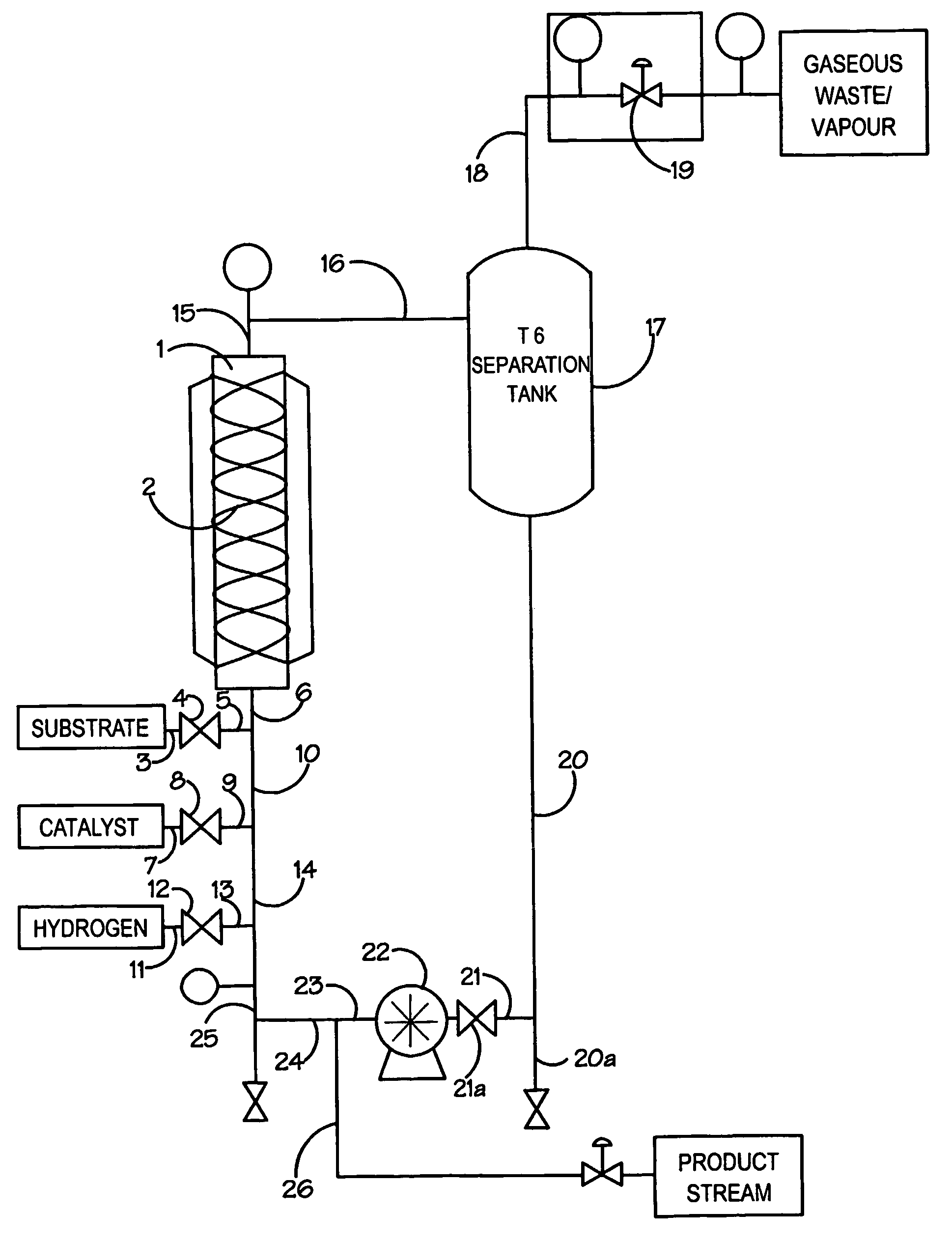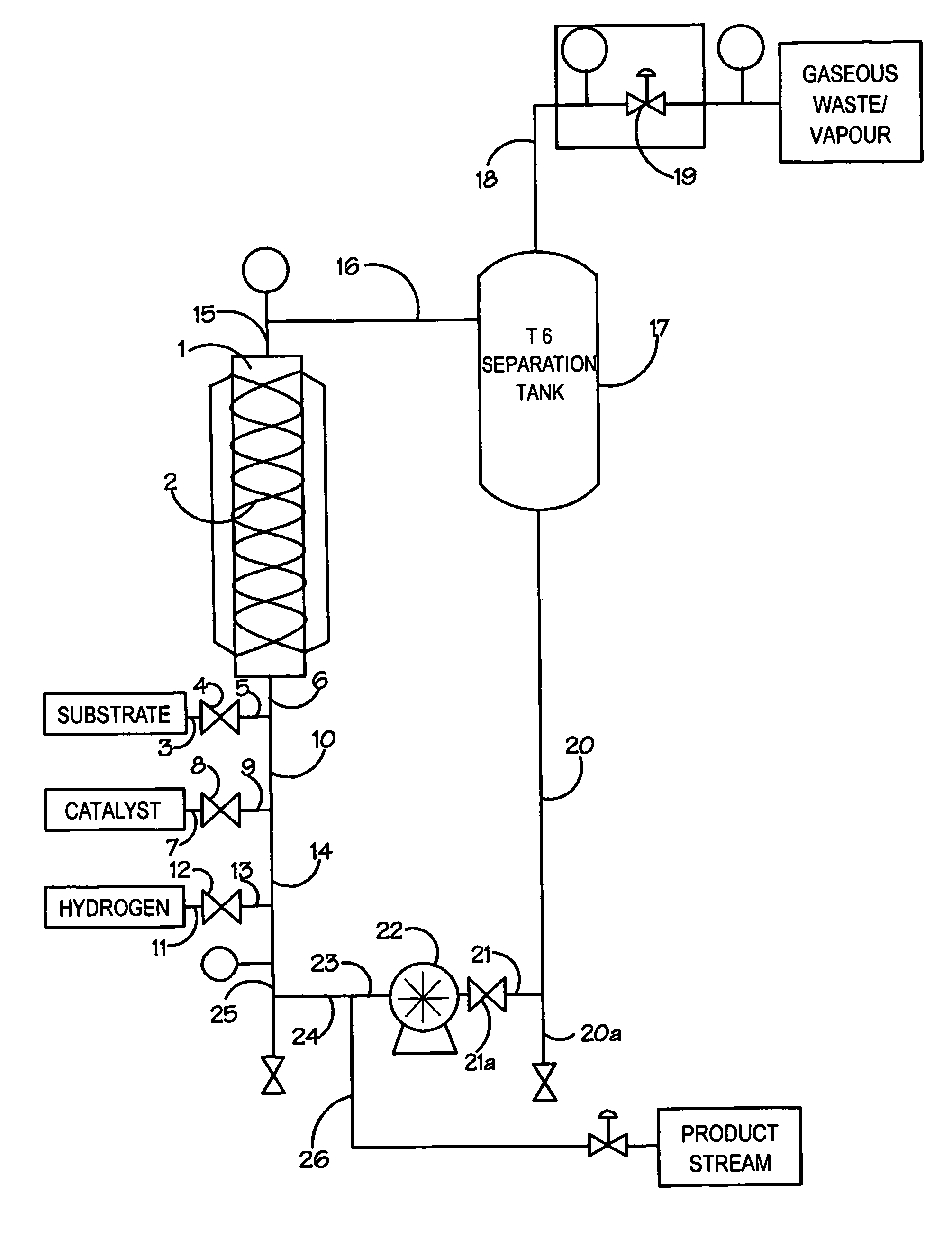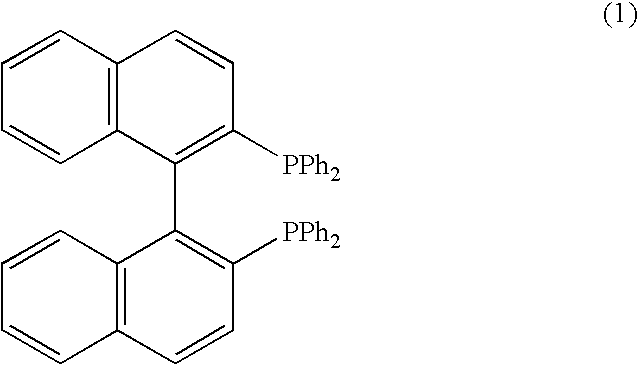Continuous process for the enantioselective catalytic hydrogenation of beta-ketoesters
a technology of enantioselective catalysis and hydrogenation process, which is applied in the preparation of carboxylic acid esters, chemistry apparatus and processes, and organic chemistry, etc., can solve the problems of unsatisfactory commercial development, unpractical on a commercial scale, and high cost of binap or other bisaryl bisphosphine-based ligand catalysts, and achieves the largest cost in these processes and the lowest cos
- Summary
- Abstract
- Description
- Claims
- Application Information
AI Technical Summary
Benefits of technology
Problems solved by technology
Method used
Image
Examples
example 2
[0036]A feed tank was charged with 3.6 L ethanol solvent. The solvent was deoxygenated by pumping it through a spray nozzle whilst pressurising to 7 bar with nitrogen and then depressurising through a needle valve at a controlled rate. The pressurisation / depressurisation cycle was repeated three times and the entire process automated using a PLC-based control system. In a similar manner a second feed tank was charged with ethyl-4-chloroacetoacetate (3.6 L) and deoxygenated using the same protocol to that described above. The catalyst, (R)-[RuCl2(BINAP)]n (149 mg) was charged into a transfer vessel and the vessel purged using nitrogen before transferring the catalyst into the solvent feed tank. The catalyst solution had a concentration of 52.2 mg / Kg.
[0037]The two feed systems were connected to the continuous hydrogenation reactor system via two high-pressure pumps. The continuous hydrogenation reactor system was constructed of Hastalloy 276 and comprised a number of in-line static mi...
example 3
[0040]The reactor was set up as Example 2, except it was operated as a continuous loop reactor. The flow rate of the ethyl-4-chloroacetoacetate was set to 2.55 ml / minute and the flow rate of the ethanol catalyst solution set to 6.60 ml / min at a catalyst concentration of 45.8 mg / kg. These flows gave a process concentration of 37% w / w and a substrate to catalyst ratio of 65,000:1.
[0041]Over a series of continuous runs, each varying between 4 and 8 hours, the reactor consistently converted >99% ethyl-4-chloroacetoacetate to (S)-ethyl-4-chloro-3-hydroxybutyrate which was isolated after removing the solvents by evaporation to give a chemical yield of >98% and an enantiomeric excess of 98–99%.
example 5
[0043]A feed tank was charged with 3.6 L ethanol solvent. The solvent was deoxygenated by pumping it through a spray nozzle whilst pressurising to 7 bar with nitrogen and then depressurising through a needle valve at a controlled rate. The pressurisation / depressurisation cycle was repeated three times and the entire process automated using a PLC-based control system. In a similar manner a second feed tank was charged with 6-chloro-3,5-dioxo-hexanoic acid tert-butyl ester (3.6 L) and deoxygenated using the same protocol to that described above. The catalyst, (R)-[RuCl2(BINAP)]n (150 mg) was charged into a transfer vessel and the vessel purged using nitrogen before transferring the catalyst into the solvent feed tank. The catalyst solution had a concentration of 52.6 mg / Kg.
[0044]The two feed systems were connected to the continuous hydrogenation reactor system via two high-pressure pumps. The continuous hydrogenation reactor system was constructed of Hastalloy 276 and comprised a numb...
PUM
| Property | Measurement | Unit |
|---|---|---|
| Temperature | aaaaa | aaaaa |
| Temperature | aaaaa | aaaaa |
| Fraction | aaaaa | aaaaa |
Abstract
Description
Claims
Application Information
 Login to view more
Login to view more - R&D Engineer
- R&D Manager
- IP Professional
- Industry Leading Data Capabilities
- Powerful AI technology
- Patent DNA Extraction
Browse by: Latest US Patents, China's latest patents, Technical Efficacy Thesaurus, Application Domain, Technology Topic.
© 2024 PatSnap. All rights reserved.Legal|Privacy policy|Modern Slavery Act Transparency Statement|Sitemap



